Volos railway station
| ||||||||||||||||
|---|---|---|---|---|---|---|---|---|---|---|---|---|---|---|---|---|
 Volos station 2005 | ||||||||||||||||
| Location |
Volos 383 34, Magnesia Greece | |||||||||||||||
| Coordinates | 39°21′54″N 22°56′12″E / 39.3651°N 22.9366°ECoordinates: 39°21′54″N 22°56′12″E / 39.3651°N 22.9366°E | |||||||||||||||
| Owned by | OSE | |||||||||||||||
| Line(s) | Volos-Milies railway (partially disused) | |||||||||||||||
| Platforms | 2 (1 side platform, 1 island platform | |||||||||||||||
| Tracks | 2 | |||||||||||||||
| Train operators | TrainOSE | |||||||||||||||
| Construction | ||||||||||||||||
| Structure type | at-grade | |||||||||||||||
| Platform levels | 1 | |||||||||||||||
| Parking | yes | |||||||||||||||
| Disabled access |
| |||||||||||||||
| Other information | ||||||||||||||||
| Website | http://www.ose.gr/en/ | |||||||||||||||
| History | ||||||||||||||||
| Opened | 22 April 1884 | |||||||||||||||
| Services | ||||||||||||||||
| ||||||||||||||||
| Location | ||||||||||||||||
 Volos Location within Greece | ||||||||||||||||
The Volos railway station (Greek: Σιδηροδρομικός Σταθμός Βόλου, Sidirodromikos Stathmos Volos) is a railway station in Volos, Greece. located within the city itself (close to the harbour). Opened on 22 April 1884 by the Thessaly Railways (now part of OSE). Today TrainOSE operates three daily local trains to Larissa. Previously Thessaly Railways oparted a narrow gage service to Mileai from Volos, however this service now stats from Ano Lechonia (12km from Volos).[1]
History
The station was opened on 22nd April 1884, an inauguration led by King George.[2]
The station building (and the line) was designed by the Italian Evaristo De Chirico, (father of Giorgio de Chirico) soon after the liberation of Central Greece from the Ottomans. Part of the station still functions in this picturesque 1884 structure, reminiscent of a stately home to some. The adjacent neoclassical building, built between 1900 and 1903 under Evaristo De Chirico, served as the administrative headquarters of the Thessaly Railways.The building remains much the same the day it was constructed and is one of the few buildings that survived the earthquakes that hit Volos in the 1950s. Its roof is birch and has a wooden outline. Outside the station there is a statue of the goddess Athena, the work of the Italian sculptor I. Previsan.[3]
In 1960 the line from Larissa to Volos was converted to standard gauge and connected at Larissa with the mainline from Athens to Thessaloniki, allowing OSE to run through services to Volos from Athens and Thessaloniki. Volos station was converted to dual gauge, in order to accommodate trains of the two branches. Parts of the station and the track towards the city centre were at this period of a unique triple-gauge system: standard gauge for Larissa trains, metre gauge for Kalambaka trains and 600 mm gauge for Pellon trains.
The section from Volos to Agria line was operated as a heritage railway by "The Friends of Pelion Railway" between 1987 and 1994, but OSE forced them to terminate the operation in a row over competition. However, in 1996 OSE reopened the section from Ano Lechonia to Mileai as a heritage railway, initially using steam traction and converting to diesel traction in 1999.[4] However there is currently no connection between Volos and Ano Lekhonia.
Today the first floor of the station building is given over to a museum.[3]
Services
Today, the city is served by direct lines to the rest of Greece, via Larissa and the railway complex houses facilities for train maintenance. Volos is directly linked with Athens once per day, with Thessaloniki twice per day, and with Larissa 15 times a day. In the past Volos was served by railway lines of three different gauges, the metre gauge line of Thessaly Railways to Kalambaka, the standard gauge line to Larissa and the 600 mm (1 ft 11 5⁄8 in) gauge line to Pelion. Remnants of triple gauge lines still exist near the station.
Currently, the Pelion railway operates for touristic heritage service every Saturday, Sunday and public holiday from mid-April to the end of October from Ano Lehonia. The train runs every day during July and August and can be reached using the Volos–Lehonia-Platanidia bus line, currently no services call at Volos.
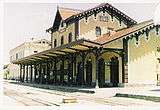
.jpg)
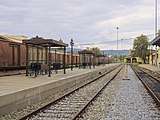
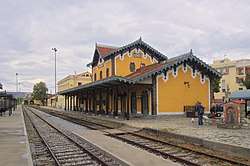
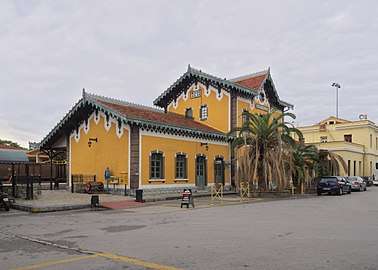
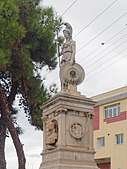
References
- ↑ http://www.trainose.gr/en/tourism-culture/train-and-recreation/the-pelion-train/
- ↑ "Σιδηροδρομικός Σταθμός Βόλου- Το κόσμημα της πόλης και η ιστορία του (photos) - e-thessalia.gr". 22 August 2015.
- 1 2 "TrainOSE". www.trainose.gr.
- ↑ Organ, J. (2006). Greece Narrow Gauge. Middleton Press. ISBN 1-904474-72-1.
| Wikimedia Commons has media related to Volos railway station. |